On a day in March 2009, Cardinal Karl Lehmann sat down and looked ahead at the day he would pass from this life into the eternal life. Almost nine years to the day later, his successor would lead his funeral Mass and share the spiritual testament with the world.

In a requiem Mass celebrated by Bishop Peter Kohlgraf (who also marked his 51st birthday) and five other bishops*, and in the presence of almost the entire German episcopacy (as well as Cardinals Adrianus Simonis from the Netherlands and Walter Kasper from Rome), Cardinal Karl Lehmann was interred in Mainz’s Cathedral of St. Martin of Tours and St. Stephen today. After the Mass was concluded, the text of the cardinal’s spiritual testament was published on the diocese’s Facebook page. Below, I share my translation.
“In the name of the Father, the Son and the Holy Spirit. Amen.
My testament as bishop
I thank God for all gifts, especially the people He has given me, especially also my parents, teachers and my homeland. I am greatly thankful for the many full-time and voluntary sisters and brothers with whom I was allowed to work and who have supported me.
Theology and Church have been the breath of my life. I would choose thusly again! We all , especially in the time after 1945, have buried ourselves deeply in the world and the times, also in the Church. This is also true for me. I pray God and the people for forgiveness. Renewal must come deeply from faith, hope and love. Hence I remind all of the words of my motto, which come from Saint Paul, and which have become ever more important for me: “Stand firm in the faith!”
With gratitude and a request for prayer for me, I greet the Holy Father, the bishops, priest and deacons, all coworkers and all sisters and brothers in the Diocese of Mainz, in my home Diocese of Freiburg im Breisgau, as well as friends in our Church and in ecumenism, and the Catholics of our country, for whom I gladly was chairman of the German Bishops’ Conference for more than 20 years. I was always concerned with the unity in faith in the diversity of our lives, without blinkers and uniformity.
I leave the arrangement of the requiem Mass and the burial to the cathedral chapter and the auxiliary bishops. We have many good customs!
There are two things under which I have suffered time and again, and ever more: In many ways, our earth and, to a large extent, our lives are wonderful, beautiful and fascinating, but they are also profoundly ambiguous, destructive and terrible. Lately, the frightfulness of power and how man deals with it has dawned on me more and more. Brutal thought and the reckless pursuit of power are to me among the harshest expressions of unbelief and sin. Resist their beginnings! I increasingly keep Jesus’ words from Luke in mind:”When the Son of Man comes, will he find faith on earth?” Choose a good successor! Pray for him and for me! Goodbye!”
Mainz, 15 March 2009
+ Karl Cardinal Lehmann
Bishop of Mainz

In his homily, Bishop Kohlgraf fondly remembered the popularity of Cardinal Lehmann, something that was proven in the days after his death by what people shared on social media:
“One shared that Bishop Lehmann had confirmed him and how much that meant to him. Others shared everyday encounters in the street and small conversations. I know of others for whom the cardinal was a true pastor and guide on he search for a personal faith. Not without reason do the people of the Diocese of Mainz call him “our Karl”. He was able to converse with everyone: with the so-called simple folk and with those with social, ecclesiastical and political influence.”
Bishop Kohlgraf referred to the cardinal’s spiritual testament several times. About the comment that the Church had ‘buried’ itself in society in the last decades, the bishop said:
“A Church burying itself in the times: in its brevity and poignancy this sentence seems to me to be prophetic. The temptation to plan and create everything, as if administration, planning, material possession is the decisive factor, does not grow smaller. In this way our late cardinal warns us to live according to faith, hope and love, before starting to “create”. The source, which gives us true life, must not be forgotten.”
Cardinal Lehmann instead insisted that the search for God lay in the heart of people: something that is innate to all human beings. This search leads to a God who has a name, who can be addressed.
“The God of the Bible is a God who enters into history, a good of liberation, who accompanies people, “God with us”. He ultimately reveals Himself unparalleled in Jesus Christ. The cardinal’s coat of arms contains an open Bible, a reference to this God who speaks to people and joins them on the way: on the coffin today, likewise, there lies an open Bible. Today, God is also “God with us”. Since this God is so great and has numerous ways of speaking, there is an endless number of ways to come to Him, as numerous as the people and their means of expressing themselves. Theology must be diverse, faith experiences must be possible for different people, faith is not narrow, not uniform”.
The requiem and funeral Mass for Cardinal Lehmann was witnessed by thousands of people along the route of the funeral procession, in the cathedral and on the square in front of it, where faithful could watch the proceedings on big screens. Among the guests were the prime ministers of the federal states of Hesse and Rhineland-Palatinate, on whose territory the Diocese of Mainz is located. Federal President Frank-Walter Steinmeier arrived under police escort when the procession had entered the cathedral. Chancellor Angela Merkel had wanted to be there, but had duties in Berlin. She is expected to attend tomorrow’s requiem service in Berlin’s St. Hedwig cathedral.
*Concelebrating with Bishop Kohlgraf were Archbishop Nikola Eterovic, Apostolic Nuncio to Germany; Reinhard Cardinal Marx, president of the German Bishops’ Conference; Gerhard Cardinal Müller, former priest of the Diocese of Mainz; Bishop Gebhard Fürst of Rottenburg Stuttgart, representing the Oberrhein Church Province, from which Cardinal Lehmann hails; Bishop Ulrich Neymeyr of Erfurt, former priest and auxiliary bishop of Mainz; and Bishop Udo Bentz, auxiliary bishop of Mainz.
Photo credit: [1] Arne Dedert (dpa), [2] Boris Roessler (dpa)
 Although not unexpected following the prayer request for his health, issued last week by Bishop Peter Kohlgraf, the death of Cardinal Karl Lehmann, early yesterday morning, is a sad conclusion to a long lifetime of service to the Church, one that coincided with and shaped the past decades of her life and development.
Although not unexpected following the prayer request for his health, issued last week by Bishop Peter Kohlgraf, the death of Cardinal Karl Lehmann, early yesterday morning, is a sad conclusion to a long lifetime of service to the Church, one that coincided with and shaped the past decades of her life and development.

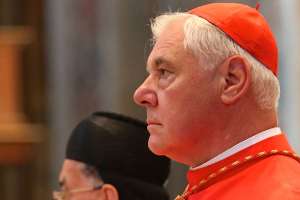 Suddenly, an increase in rumours that Cardinal Gerhard Müller is to be let go as Prefect of the Congregation for the Doctrine of the Faith appeared tonight. Should the rumours prove true, what can we say about it now?
Suddenly, an increase in rumours that Cardinal Gerhard Müller is to be let go as Prefect of the Congregation for the Doctrine of the Faith appeared tonight. Should the rumours prove true, what can we say about it now? Deacon Jesús Mauricio Meneses Santiago (pictured, fourth from the left) is Colombian. He came to the Archdiocese of Utrecht as one of four religious, wanting to do something in return for the Dutch missionaries who had come to Colombia in the past. His three fellow religious returned home over the years, but Deacon Meneses Santiago decided to stay. He says: “That was not an easy choice. But I wanted to remain true to my calling. And I am happy. The Netherlands have stolen my heart and I feel at home here. My vocation is God’s initiative, I am here for a reason. I will continue this mission that God has entrusted me with.”
Deacon Jesús Mauricio Meneses Santiago (pictured, fourth from the left) is Colombian. He came to the Archdiocese of Utrecht as one of four religious, wanting to do something in return for the Dutch missionaries who had come to Colombia in the past. His three fellow religious returned home over the years, but Deacon Meneses Santiago decided to stay. He says: “That was not an easy choice. But I wanted to remain true to my calling. And I am happy. The Netherlands have stolen my heart and I feel at home here. My vocation is God’s initiative, I am here for a reason. I will continue this mission that God has entrusted me with.”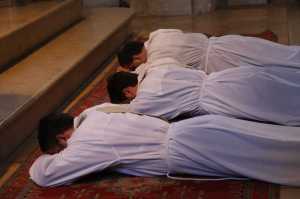 Diocese of Eichstätt, ordained by Bishop Gregor Maria Hanke
Diocese of Eichstätt, ordained by Bishop Gregor Maria Hanke Archdiocese of Paderborn, ordained by Bishop Manfred Grothe
Archdiocese of Paderborn, ordained by Bishop Manfred Grothe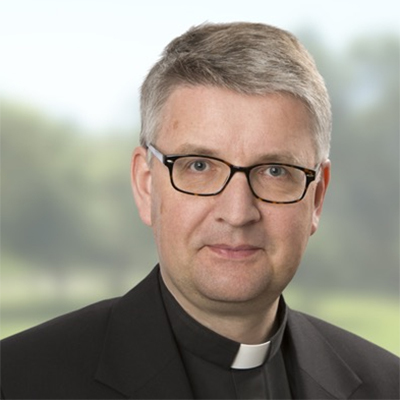 Almost a year after the retirement of Cardinal Karl Lehmann, all the dioceses of Germany have a bishop at the helm again – a situation that has not existed for several years. Succeeding the cardinal who led the Diocese of Mainz for 33 years is Father Peter Kohlgraf.
Almost a year after the retirement of Cardinal Karl Lehmann, all the dioceses of Germany have a bishop at the helm again – a situation that has not existed for several years. Succeeding the cardinal who led the Diocese of Mainz for 33 years is Father Peter Kohlgraf.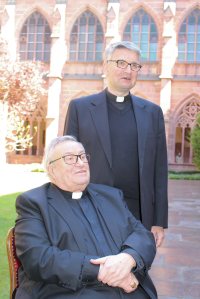
 Back to Rottenburg-Stuttgart. The successor of 70-year-old Bishop Johannes Kreidler, who has retired for health reasons, is 48-year-old Matthäus Karrer. The new bishop is a member of the cathedral chapter and heads the department of pastoral planning in the Diocese of Rottenburg-Stuttgart. He joins Bishop Gebhard Fürst and Auxiliary Bishop Thomas Renz at the head of that diocese, which covers the central and eastern part of the State of Baden-Württemberg. Bishop-elect Karrer studied theology in Tübingen and Munich, writing a dissertation on “marriage and family as house Church”. He was ordained to the priesthood in 1995. In 2008, after more than a decade as parish priest in several locations, he was appointed as the first Dean of Allgäu-Oberschwaben.
Back to Rottenburg-Stuttgart. The successor of 70-year-old Bishop Johannes Kreidler, who has retired for health reasons, is 48-year-old Matthäus Karrer. The new bishop is a member of the cathedral chapter and heads the department of pastoral planning in the Diocese of Rottenburg-Stuttgart. He joins Bishop Gebhard Fürst and Auxiliary Bishop Thomas Renz at the head of that diocese, which covers the central and eastern part of the State of Baden-Württemberg. Bishop-elect Karrer studied theology in Tübingen and Munich, writing a dissertation on “marriage and family as house Church”. He was ordained to the priesthood in 1995. In 2008, after more than a decade as parish priest in several locations, he was appointed as the first Dean of Allgäu-Oberschwaben.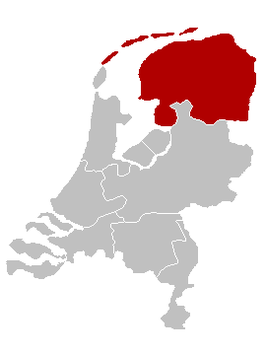 There have been years when the changes were rather significant, but 2017 does not look to be one of those. At the start of the new year, three dioceses are without a bishop: Groningen-Leeuwarden in the Netherlands (map at right), Mainz in Germany and the Territorial Prelature of Trondheim in Norway. It is a safe bet that the first two will receive their new bishops in 2017, but Trondheim may well be left as it has been for the past seven years: without a bishop, and with the bishop of Oslo serving as Apostolic Administrator. But on the other hand, for a see that just built and consecrated its new cathedral, and which, like the rest of Norway, has seen a significant increase in Catholic faithful, this does not seem like a situation that will continue forever. So who knows what the year will bring.
There have been years when the changes were rather significant, but 2017 does not look to be one of those. At the start of the new year, three dioceses are without a bishop: Groningen-Leeuwarden in the Netherlands (map at right), Mainz in Germany and the Territorial Prelature of Trondheim in Norway. It is a safe bet that the first two will receive their new bishops in 2017, but Trondheim may well be left as it has been for the past seven years: without a bishop, and with the bishop of Oslo serving as Apostolic Administrator. But on the other hand, for a see that just built and consecrated its new cathedral, and which, like the rest of Norway, has seen a significant increase in Catholic faithful, this does not seem like a situation that will continue forever. So who knows what the year will bring. There are a few bishops who will reach the age of 75 in 2017, and thus will offer their resignation. In Germany, these are Bishop Friedhelm Hofmann of Würzburg on 12 May and Norbert Trelle (at left) of Hildesheim on 5 September. Joining them is Bishop Frans Wiertz of Roermond in the Netherlands. He will be 75 on 2 December, but I would not be surprised if his retirement will be accepted earlier, as the bishop has been struggling with eye-related health problems.
There are a few bishops who will reach the age of 75 in 2017, and thus will offer their resignation. In Germany, these are Bishop Friedhelm Hofmann of Würzburg on 12 May and Norbert Trelle (at left) of Hildesheim on 5 September. Joining them is Bishop Frans Wiertz of Roermond in the Netherlands. He will be 75 on 2 December, but I would not be surprised if his retirement will be accepted earlier, as the bishop has been struggling with eye-related health problems.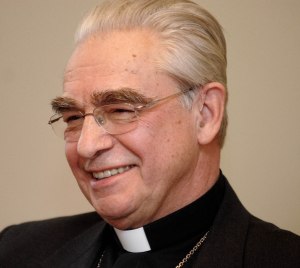 In Rome, lastly, there will be no new consistory. Only four cardinals will reach the age of 80 and so cease to be electors. They are Audrys Backis, Archbishop emeritus of Vilnius, Lithuania (and former Nuncio to the Netherlands) (at right); Raymundo Damasceno Assis, Archbishop emeritus of Aparecida, Brazil; Attilio Nicora, Pontifical Legate to the Basilicas in Assisi, Italy; and Lluís Martínez Sistach, Archbishop emeritus of Barcelona, Spain. The number of cardinals who will be able to participate in a conclave will still be 116 at the end of next year, so there will be no need to bring their numbers up.
In Rome, lastly, there will be no new consistory. Only four cardinals will reach the age of 80 and so cease to be electors. They are Audrys Backis, Archbishop emeritus of Vilnius, Lithuania (and former Nuncio to the Netherlands) (at right); Raymundo Damasceno Assis, Archbishop emeritus of Aparecida, Brazil; Attilio Nicora, Pontifical Legate to the Basilicas in Assisi, Italy; and Lluís Martínez Sistach, Archbishop emeritus of Barcelona, Spain. The number of cardinals who will be able to participate in a conclave will still be 116 at the end of next year, so there will be no need to bring their numbers up.
 The Diocese of Limburg was established in 1821 to cater to the Catholics in the then-current Duchy of Nassau, as well as the Free City of Frankfurt. Its territory was taken from the adjacent dioceses of Trier and Mainz. Originally a suffragan see of Freiburg, in 1929 it became a part of the Province of Cologne. In 1930 and 1933 it gained some more territory, from Fulda and Trier respectively. There are some 645,000 Catholics in the diocese, out of a total population of 2.4 million. It has few major cities aside from Wiesbaden and Frankfurt am Main, with the majority of Catholics concentrated in the south and northwest.
The Diocese of Limburg was established in 1821 to cater to the Catholics in the then-current Duchy of Nassau, as well as the Free City of Frankfurt. Its territory was taken from the adjacent dioceses of Trier and Mainz. Originally a suffragan see of Freiburg, in 1929 it became a part of the Province of Cologne. In 1930 and 1933 it gained some more territory, from Fulda and Trier respectively. There are some 645,000 Catholics in the diocese, out of a total population of 2.4 million. It has few major cities aside from Wiesbaden and Frankfurt am Main, with the majority of Catholics concentrated in the south and northwest. In the Netherlands, to begin with, a new bishop will arrive in the Diocese of ‘s-Hertogenbosch. Bishop Antoon Hurkmans (right) has already has his resignation on health grounds accepted and it shouldn’t take more than a few more months for his successor in the country’s largest diocese (in numbers at least) to be named. Will it be current Auxiliary Bishop Rob Mutsaerts? Who’s to say.
In the Netherlands, to begin with, a new bishop will arrive in the Diocese of ‘s-Hertogenbosch. Bishop Antoon Hurkmans (right) has already has his resignation on health grounds accepted and it shouldn’t take more than a few more months for his successor in the country’s largest diocese (in numbers at least) to be named. Will it be current Auxiliary Bishop Rob Mutsaerts? Who’s to say. In Germany, three prelates are expected to retire this year. First of all the long-serving Bishop of Mainz, Cardinal Karl Lehmann (left), who will reach the age of 80 in May. Losing his voting rights in the conclave and his memberships in the Curia, his retirement is expected to follow around the same time. The Diocese has already announced that Cardinal Lehmann will continue to live in his current home, while the former abode of Cardinal Volk, bishop of Mainz from 1962 to 1982. Cardinal Lehmann has headed Mainz since 1983.
In Germany, three prelates are expected to retire this year. First of all the long-serving Bishop of Mainz, Cardinal Karl Lehmann (left), who will reach the age of 80 in May. Losing his voting rights in the conclave and his memberships in the Curia, his retirement is expected to follow around the same time. The Diocese has already announced that Cardinal Lehmann will continue to live in his current home, while the former abode of Cardinal Volk, bishop of Mainz from 1962 to 1982. Cardinal Lehmann has headed Mainz since 1983. In Limburg we may finally expect the arrival of a new bishop. Administrator Bishop Manfred Grothe (right) will be 77 in April and has already retired as auxiliary bishop of Paderborn. In March, it will be two years since Bishop Tebartz-van Elst was made to retire, and according to Bishop Grothe, the time is just about ready for his successor to be named.
In Limburg we may finally expect the arrival of a new bishop. Administrator Bishop Manfred Grothe (right) will be 77 in April and has already retired as auxiliary bishop of Paderborn. In March, it will be two years since Bishop Tebartz-van Elst was made to retire, and according to Bishop Grothe, the time is just about ready for his successor to be named. In the Archdiocese of Hamburg, the last auxiliary bishop, Hans-Jochen Jaschke (left) will reach the age of 75 in September. This may mean that Archbishop Stefan Heße will be requesting one or more new auxiliary bishops from Rome, either this or next year.
In the Archdiocese of Hamburg, the last auxiliary bishop, Hans-Jochen Jaschke (left) will reach the age of 75 in September. This may mean that Archbishop Stefan Heße will be requesting one or more new auxiliary bishops from Rome, either this or next year. In Belgium then, Ghent’s Bishop Luc Van Looy (right) will turn 75 in September. The Salesian, who became president of Caritas Europe and was among Pope Francis’ personal choices to attend the Synod of Bishops last year, has been bishop of Ghent since 2003.
In Belgium then, Ghent’s Bishop Luc Van Looy (right) will turn 75 in September. The Salesian, who became president of Caritas Europe and was among Pope Francis’ personal choices to attend the Synod of Bishops last year, has been bishop of Ghent since 2003. In Rome, another Belgian bishop will reach the retirement age in April, Archbishop Frans Daneels (left), secretary of the Apostolic Signatura and a Norbertine priest, may return to Averbode Abbey in Belgium, where he made his profession in 1961.
In Rome, another Belgian bishop will reach the retirement age in April, Archbishop Frans Daneels (left), secretary of the Apostolic Signatura and a Norbertine priest, may return to Averbode Abbey in Belgium, where he made his profession in 1961.